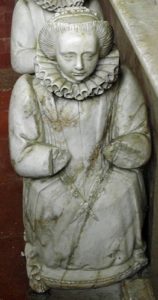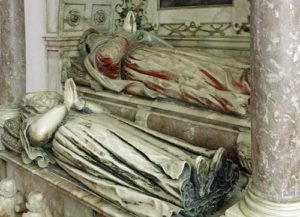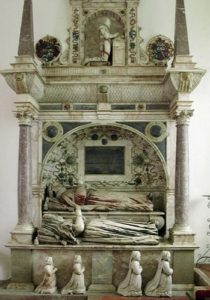Glentworth is one of a series of small villages north of Lincoln, built along the bottom of the cliff, off the B1398. it is a place you pass by but don’t bother to stop. We had spent the day visiting some of the churches in rural Lincolnshire so husband could try out his new camera. In Snarford Church (see review) there was a board listing other churches worth visiting in the area and this was on it with a comment about splendid family tombs. It was on our way home, so we dropped down the hill to find it.
It is set in a large well care for graveyard and has a beautiful Saxon tower with the characteristic small double Saxon windows. The line of the original thatched roof can still be seen on the tower. The nave is later and the chancel extended at an even later date. From the outside it is a long low building made from the local ironstone. Entry is through the south door which has a small porch.
It is very plain inside with a low chancel arch and gothic windows. At the west end is a Saxon arch leading to the base of the tower. We were very aware of the loud tick of the church clock.
The chancel was rebuilt and extended in Elizabethan times to make room for the massive monument to Sir Christopher Wray. He was the Chief Justice of England under Elizabeth I and responsible for passing the death sentence on Mary Queen of Scots, although he was not present at her execution. A large square window was built into the east wall during the rebuild, to provide more light on the tomb. The window has a picture of the last supper at the bottom with scenes of the crucifixion above. The predominant colour of the glass is grey with patches of red and yellow.
The tomb is described as an ‘Elizabethan alabaster gem’ and is similar to that of Sir George St Paul at Snarford. Perhaps he got the idea from here, as his wife Frances was one of the children featured on the bottom of the monument.
The figures of Sir Christopher and his wife, Anne, are shown lying on their sides with their heads on pillows and hands clasped in prayer. The bodies are set in a niche with Sir Christopher above his wife. He is wearing a black cap and his red gown of office. She has a black dress and a cowl head dress. On either side is an alabaster pillar with acanthus leaf capitals and a tall narrow pyramid on the top. The underside of the arch is decorated with painted flowers. On the back is the memorial plate surrounded by coloured roundels and skulls. Along the base of the monument are the figures of four kneeling daughters in ruffs and farthingales. One is Frances. Two of the daughters died in infancy.
Above the tomb is the kneeling figure of their son and heir, William who is surrounded by a portico with roundels with coats of arms on either side.
On the opposite wall is the white alabaster memorial to Elizabeth Saunderson who died in 1714. She was the great, great grand daughter of Sir Charles. Her memorial has three alabaster cherub heads in the centre under a draped canopy. On either side are two pillars with acanthus leaf capitals supporting the top which has a family crest with a small white dog with black spots above. On either side are chubby naked male boys. Beneath is a dedication to Elizabeth with details of her family history and extolation of her goodness and greatness.
This church gets little mention in local guide books and has few visitors. It is worth visiting for the splendid Wray tomb. The church is unlocked during day light hours and there is plenty of parking by the village hall close by.
As well as Snarford, it makes a nice day out with Stow Minster and St Edith’s Church at Coates (see reviews).
http://homepage.ntlworld.com/peter.fairweather/docs/Glentworth.htm
http://homepage.ntlworld.com/peter.fairweather/docs/Glentworth_wray.htm










